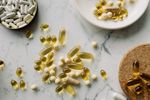Avoid that dry, dull complexion with these expert tips for keeping your skin healthy all winter.
There are plenty of things to love about the winter: cozy days by the fire, chunky sweaters, a warm cup of adaptogenic hot cocoa. What’s not quite so enjoyable is the havoc the season can wreak on your skin; cold, dry weather can lead to a host of complexion concerns, including dryness, flaking, itchiness and more. And while living in a colder climate might put you especially at risk for seasonal dermatological troubles, those in balmier regions can still experience a drop in temperatures and humidity (even if relative!) that can affect their skin, too.
Happily, making a few seasonal swaps to your skincare routine — both when it comes to products and habits — can help prevent and treat all of the above. Here, six expert-backed tips and tricks to keeping your skin in tip-top shape all season long.
Layer On More Moisture
“The water content in your skin decreases during the winter due to the cold air, indoor dry heat, lack of humidity and blustery wind,” explains New York City dermatologist Barry Goldman, MD. He adds that there’s even some evidence that your natural sebum (aka oil) production decreases during the winter as well. Point being: Using your regular ol’ moisturizer may not be sufficient.
When it comes to adding moisture back to the skin, think about it in the same way you’d get dressed during the winter — layers are key, says Miriam Cardoos, lead esthetician at THE WELL New York. That starts even with the cleanser you’re using; rather than foaming formulas, which are innately more stripping, switch to a cream- or oil-based face wash, she suggests.
Next, apply a serum that contains humectant ingredients, such as hyaluronic acid or glycerin, which attracts water to the skin, trapping it within. Then comes a moisturizer followed by a face oil. Many people use face oils alone, but they’re really best used as a finishing step to lock in all of the other moisture you’ve added from the other products, Cardoos notes.
RELATED: Lose the Lotion: Why You Should Switch to Body Oils
Rethink Your Shower Strategy
A hot shower may sound very appealing when it’s freezing outside, but it’s not going to do your skin any favors — quite the opposite, actually. “Hot water temperatures are irritating to the skin, causing inflammation that can lead to the disruption of the skin barrier,” explains Robert Anolik, MD, a board-certified dermatologist in New York City. This outermost layer of skin is already under attack from the outdoor elements, so a steaming shower will only add insult to injury.
Dr. Anolik advises opting for lukewarm water lukewarm and limiting your shower time to no more than 10 minutes. Once you get out, pat dry with a towel and slather on moisturizer right away. “The sooner you can apply it, the better, so that it can trap the moisture that’s already on your skin,” says Dr. Goldman. His other tip? Use a cream for your body found in a jar or tub rather than a lotion in a pump bottle, as the former will be thicker, richer and more moisturizing.
Use a Humidifier
“When there’s lower humidity in the air, as is the case in the winter, the air ‘steals’ moisture from the skin,” explains Cardoos. Not to mention that the indoor heat that's cranked up at home further dries out the ambient air, adds Tess Mauricio, MD, a board-certified dermatologist in Beverly Hills.
While you can’t change the weather, you can pick up a humidifier to keep in your bedroom and use overnight. It will add moisture back into to the air while you sleep, a boon not only for your skin but also your throat and nasal passages, too, she points out.
RELATED: How to Make Your Home a Sanctuary
“When there’s lower humidity in the air, as is the case in the winter, the air ‘steals’ moisture from the skin."
Cut Back on Drying Ingredients
Retinoids, alpha-hydroxy acids, other exfoliants — these are all known to be innately drying to the skin. You don’t want to press pause on these ingredients all winter long; after all, they’re essential for healthy, youthful skin. More specifically, exfoliation gets rid of dead cells and actually helps your moisturizer penetrate and work better, says Dr. Mauricio. The trick is scaling back the frequency and practicing a concept some call “skin cycling,” she adds.
Rather than using your active ingredients nightly, use them every other night or even just twice per week. No matter whether you’re opting for a physical or chemical exfoliating product, limit it to once per week. But above all, pay attention to your skin. “If you’re following your regular routine and your skin looks and feels good, then stick with it. But if you’re noticing irritation, sensitivity or peeling, take a break from all active ingredients for a few days, then gradually add them back in,” she says.
Make the Most of Your Derm Appointments
Shorter days and chilly temperatures can make it especially tempting to hibernate and skip all obligations in favor of a blanket-covered spot on the couch. But it’s worth braving the elements to see your dermatologist during this time of year. In fact, this an especially great time to book your yearly skin check, suggests Dr. Mauricio.
Along with the fact that many people have healthcare benefits they need to utilize before the end of the year, winter overall also acts a good opportunity to take a pause and check in on your overall health and wellness, she says. Plus, in the event you do need to have a mole or growth removed, it’s imperative to keep the area dry, covered and out of the sun — all of which are harder to do in the summer when you’re more likely to be swimming or spending time outdoors, adds Dr. Mauricio.
And if you’ve been thinking about booking any type of in-office laser treatment, the winter months are ideal for doing so. In the days and weeks following these procedures, you want to avoid sun exposure and developing a tan or burn, as it can increase the risk of developing post-treatment hyperpigmentation, notes Dr. Anolik. In other words, opting for these procedures when you’re not going to be spending a ton of time outdoors is a good way to ensure you end up with the best results.
Don’t Forget SPF
But don't get it wrong: Even though you might be spending more time indoors during the season, that’s by no means an excuse to skip the ‘screen. “Don’t stop using daily sunscreen in the winter," Dr. Anolik explains. "Yes, the UV rays are slightly less intense, but they’re still there." And when there’s snow on the ground, that UV exposure is increased because those rays reflect off of the snow, says Cardoos, adding that this is why sunburn can be a very real issue for skiers or any sun sport enthusiasts. Bottom line: Keep using your (broad-spectrum, at least SPF 30) sunscreen every single day, 365 days per year.




